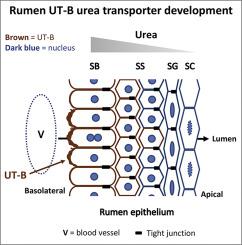Animal Nutrition ( IF 6.3 ) Pub Date : 2022-04-28 , DOI: 10.1016/j.aninu.2022.03.006 Chongliang Zhong 1 , Tamsin Lyons 1 , Orla Heussaff 1 , Evelyn Doyle 1 , Eoin O'Hara 2, 3 , Sinead M Waters 2 , David Kenny 2 , Gavin S Stewart 1

|
Urea nitrogen secreted from blood to rumen is a crucial factor shaping the symbiotic relationship between host ruminants and their microbial populations. Passage of urea across rumen epithelia is facilitated by urea transporter B (UT-B), but the long-term regulation of these proteins remains unclear. As ruminal function develops over a period of months, the developing rumen is an excellent model with which to investigate this regulation. Using rumen epithelium samples of calves from birth to 96 d of age, this study performed immunolocalization studies to localize and semi-quantify UT-B protein development. As expected, preliminary experiments confirmed that ruminal monocarboxylate transporter 1 (MCT1) short chain fatty acid transporter protein abundance increased with age (P < 0.01, n = 4). Further investigation revealed that ruminal UT-B was present in the first few weeks of life and initially detected in the basolateral membrane of stratum basale cells. Over the next 2 months, UT-B staining spread to other epithelial layers and semi-quantification indicated that UT-B abundance significantly increased with age (P < 0.01, n = 4 or 6). These changes were in line with the development of rumen function after the advent of solid feed intake and weaning, exhibiting a similar pattern to both MCT1 transporters and papillae growth. This study therefore confirmed age-dependent changes of in situ ruminal UT-B protein, adding to our understanding of the long-term regulation of ruminal urea transporters.
中文翻译:

尿素转运蛋白 B 在发育牛瘤胃中的定位
从血液分泌到瘤胃的尿素氮是影响宿主反刍动物与其微生物种群之间共生关系的关键因素。尿素转运蛋白 B (UT-B) 促进了尿素通过瘤胃上皮细胞,但这些蛋白质的长期调控仍不清楚。随着瘤胃功能在几个月内发展,发育中的瘤胃是研究这一规律的极好模型。本研究使用从出生到 96 日龄的小牛瘤胃上皮样本,进行了免疫定位研究,以定位和半量化 UT-B 蛋白的发育。正如预期的那样,初步实验证实瘤胃单羧酸转运蛋白 1 (MCT1) 短链脂肪酸转运蛋白丰度随年龄增长而增加 ( P < 0.01, n = 4)。进一步调查显示瘤胃 UT-B 存在于生命的最初几周,最初在基底层细胞的基底外侧膜中检测到。在接下来的 2 个月中,UT-B 染色扩散到其他上皮层,半定量显示 UT-B 丰度随着年龄的增长而显着增加(P < 0.01,n = 4 或 6)。这些变化与固体采食和断奶后瘤胃功能的发展一致,表现出与 MCT1 转运蛋白和乳突生长相似的模式。因此,这项研究证实了原位瘤胃 UT-B 蛋白的年龄依赖性变化,增加了我们对瘤胃尿素转运蛋白长期调节的理解。



























 京公网安备 11010802027423号
京公网安备 11010802027423号